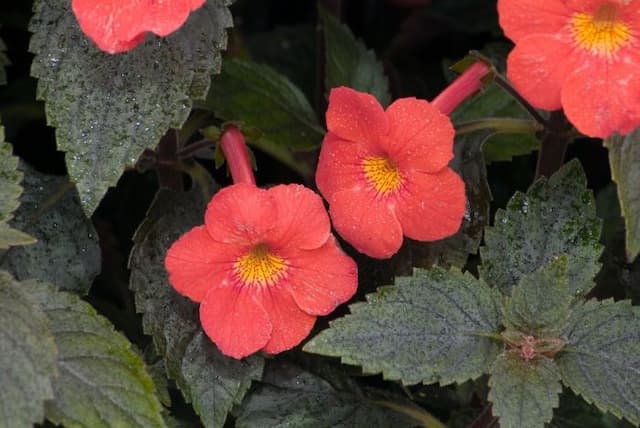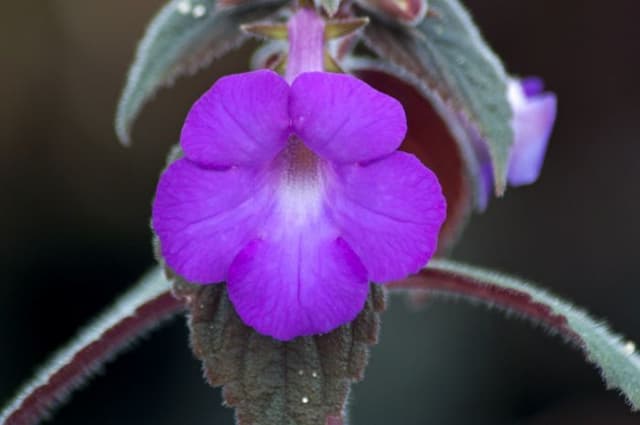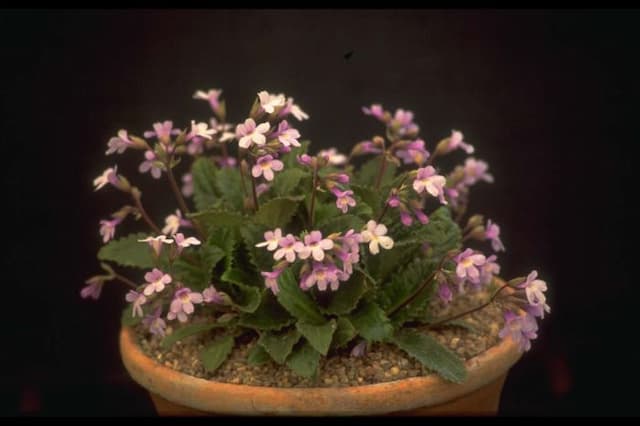Lipstick Plant Aeschynanthus pulcher

ABOUT
Commonly known as the lipstick plant, this vibrant and attractive houseplant is admired for its glossy green leaves and striking tubular flowers, which are most often red but can also come in shades of orange or yellow. The leaves typically have a slightly wavy edge, are thick, and may have a leathery texture, which adds a lush look to the foliage. The most distinctive feature is the blooms that emerge from what looks like a dark, puckered tube or "lipstick case," hence the common name. These flowers give a stunning contrast against the greenery and can add a touch of the tropics to any space they inhabit. The plant has a trailing habit, making it a perfect choice for hanging baskets or shelves where its cascading stems can drape elegantly over the sides.
About this plant
 Names
NamesFamily
Gesneriaceae
Synonyms
Basket Vine, Lipstick Plant
Common names
Aeschynanthus pulcher
 Toxicity
ToxicityTo humans
The plant commonly known as Lipstick plant (Aeschynanthus pulcher) is not considered toxic to humans. Therefore, it generally does not cause poisoning or symptoms associated with toxicity when touched or ingested in small quantities. However, it's always a good practice to keep all plants out of the reach of small children who might chew on them, as individual reactions can vary and non-toxic plants can still cause choking or gastrointestinal discomfort if ingested.
To pets
The Lipstick plant (Aeschynanthus pulcher) is generally considered non-toxic to pets, including cats and dogs. It is not known to cause any serious poisoning or severe symptoms if pets ingest it. Regardless, it is recommended to monitor pets around houseplants and discourage them from chewing on plants. Even non-toxic plants can potentially cause mild digestive upset if ingested in large amounts.
 Characteristics
CharacteristicsLife cycle
Perennials
Foliage type
Evergreen
Color of leaves
Green
Flower color
Red
Height
2 feet (60 cm)
Spread
2 feet (60 cm)
Plant type
Climber
Hardiness zones
10
Native area
Southeast Asia
Benefits
 General Benefits
General Benefits- Aesthetic Appeal: Adds vibrant colors and unique textures to home decor with its striking red or orange flowers and glossy green leaves.
- Humidity Tolerance: Thrives in humid environments, making it suitable for bathrooms or kitchens.
- Low Maintenance: Requires minimal care, with infrequent watering and no need for frequent pruning.
- Trailing Growth Habit: Suitable for hanging baskets, allowing for creative vertical gardening.
- Positive Psychological Effects: Enhances mood and reduces stress levels by adding natural beauty to living spaces.
- Long Blooming Period: Produces flowers for much of the year, offering persistent visual interest.
 Medical Properties
Medical PropertiesThis plant is not used for medical purposes.
 Air-purifying Qualities
Air-purifying QualitiesThis plant is not specifically known for air purifying qualities.
 Other Uses
Other Uses- Aeschynanthus pulcher, commonly known as Lipstick Plant, can be used in hanging baskets to add a splash of color and visual interest to patios, porches, or outdoor living areas, thanks to its trailing growth habit and vibrant flowers.
- The plant can serve as live decor for themed events or parties, especially when aiming for a tropical or jungle atmosphere, as its exotic look complements such settings.
- Lipstick Plant can be used in vivariums or terrariums as a way to mimic the natural environment for certain types of reptiles or amphibians that require high humidity and some climbing structures.
- It can be implemented in crafting floral arrangements or table centerpieces for its unique and striking blooms that add texture and a pop of color.
- Botanical artists and illustrators may use Lipstick Plant as a subject for drawing, painting, or photography due to its distinctive flower shape and lush foliage, which offer an interesting artistic challenge.
- Used as educational tools in schools or botanical gardens to teach about epiphytic plants and their growth habits, especially in tropical ecology classes.
- Given their non-toxic nature, they can safely be incorporated into pet-friendly homes where curious pets might be prone to nibble on indoor plants.
- They can act as natural humidifiers when grouped together, creating a microenvironment that can be beneficial for other plants requiring similar conditions.
- In feng shui, the Lipstick Plant might be used to introduce an element of fire into a space, symbolizing energy and transformation, due to its red flowers.
- During the holiday season, the red flowers of the Lipstick Plant can complement festive decor, offering a living alternative to traditional poinsettias.
Interesting Facts
 Feng Shui
Feng ShuiThe Lipstick Plant is not used in Feng Shui practice.
 Zodiac Sign Compitability
Zodiac Sign CompitabilityThe Lipstick Plant is not used in astrology practice.
 Plant Symbolism
Plant Symbolism- Elegance - Aeschynanthus pulcher, also known as lipstick plant, boasts strikingly beautiful, red flowers that hang elegantly, symbolizing grace and a refined beauty.
- Prosperity - With its lush, green foliage and vibrant blooms, the lipstick plant is often associated with wealth and abundance.
- Attraction - The lipstick plant's unique appearance and bright flowers are thought to symbolize allure and attracting positive attention.
- Vitality - Due to its vigorous growth habit and resilient nature, the lipstick plant is also a symbol for health and vitality.
 Water
WaterThe Lipstick Plant (Aeschynanthus pulcher) prefers consistently moist soil, but it's essential not to overwater it to prevent root rot. Generally, watering about once per week should suffice, providing approximately 8-16 ounces of water each time, depending on the size of the pot and the plant's environment. During the growing season (spring and summer), you may need to water more frequently, always checking the top inch of soil for dryness before adding water. In fall and winter, reduce watering but never allow the soil to completely dry out.
 Light
LightThe Lipstick Plant thrives in bright, indirect light, which promotes flowering and healthy growth. A spot near an east or west-facing window is ideal because it will provide the plant with plenty of light without the harshness of direct midday sun. Avoid placing your Lipstick Plant in direct sunlight, which can scorch its leaves, and also avoid deep shade, which can lead to leggy growth and fewer flowers.
 Temperature
TemperatureThe Lipstick Plant does best in a warm environment, with ideal temperature conditions between 65 and 75 degrees Fahrenheit. It can tolerate a minimum temperature of around 60 degrees Fahrenheit, but it should not be exposed to temperatures below 50 degrees Fahrenheit as it can damage the plant. Keep your Lipstick Plant away from drafts and sudden temperature changes to maintain consistent growth.
 Pruning
PruningPruning your Lipstick Plant encourages bushier growth and more blooms. Prune the plant in the spring, trimming back leggy stems and removing any dead or yellowing leaves. This can be done every couple of months or as needed to maintain shape. Always use clean, sharp scissors or pruning shears to make precise cuts without damaging the plant.
 Cleaning
CleaningAs needed
 Soil
SoilLipstick Plant thrives in well-draining, peat-based potting soil with good aeration. A mix of peat, perlite, and pine bark in equal parts suits it well. Aim for a soil pH between 5.5 and 6.5 for optimal growth.
 Repotting
RepottingLipstick Plants should be repotted every 2-3 years or when the pot is root-bound. It's best to repot in spring before the beginning of the growth season.
 Humidity & Misting
Humidity & MistingLipstick Plant prefers high humidity levels, ideally between 60% to 80% for lush growth and vibrant blooms.
 Suitable locations
Suitable locationsIndoor
Hang near a window, provide bright indirect light, and keep warm for best growth.
Outdoor
Provide partial shade, shelter from extreme weather, and ensure high humidity.
Hardiness zone
10-11 USDA
 Life cycle
Life cycleAeschynanthus pulcher, commonly known as the Lipstick Plant, begins its life cycle as a seed, which upon germination produces a small seedling. The seedling develops into a young plant with characteristic fleshy leaves and begins to exhibit vine-like growth habits. As it matures, the plant produces striking tubular flowers, often bright red, resembling a lipstick, leading to its common name. After pollination, typically by hummingbirds or insects, the flowers will develop into capsules containing seeds. These seeds are then dispersed, possibly by gravity or animal agents, to start the next generation. The Lipstick Plant can also propagate vegetatively through cuttings, which root easily and create clones of the parent plant.
 Propogation
PropogationPropogation time
Spring-Early Summer
Lipstick Plant (Aeschynanthus pulcher) can be easily propagated through stem cuttings, preferably during the warmer months of spring to early summer when the plant is most actively growing. Choose a healthy, non-flowering stem and cut a 4-6 inch (10-15 cm) piece just below a leaf node. Remove the lower leaves and dip the cutting into rooting hormone powder to encourage root growth. Plant the cutting in a pot filled with a well-draining potting mix, ensuring at least one node is buried where the roots can form. Keep the soil consistently moist but not waterlogged and place the pot in a warm, humid spot with bright, indirect light. Roots usually develop within a few weeks, and once established with new growth, the cutting can be transplanted into a larger pot or outdoors if the climate permits.









